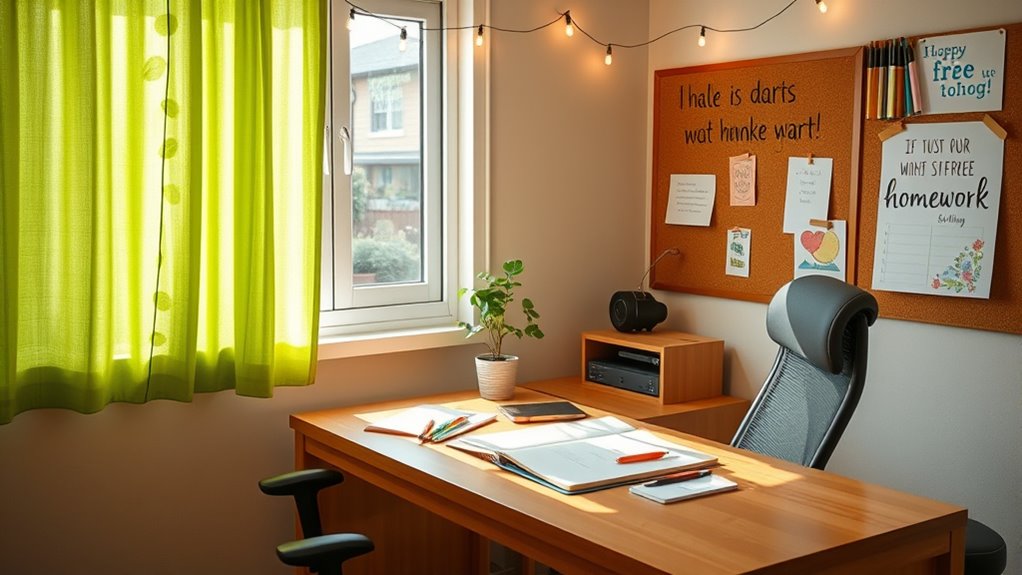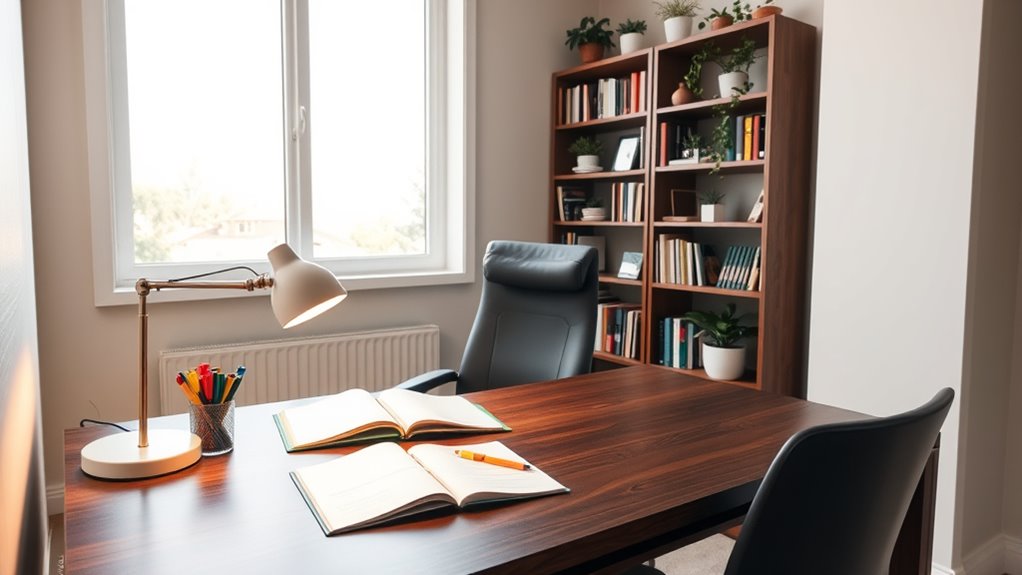Creating a dedicated, clutter-free study nook helps your child focus and makes homework less stressful. Keep the space organized with only essential materials, guarantee good lighting, and add personal touches to motivate them. Establish routines, like fixed times and a consistent spot, to build habits that encourage concentration. Inform family members about study times to reduce interruptions. Keep refining these habits, and you’ll see homework become more manageable—if you continue exploring, you’ll discover how to make it a smooth, enjoyable part of their day.
Key Takeaways
- Designate a consistent, clutter-free space with good lighting to signal focus and reduce distractions.
- Keep only essential study materials nearby to streamline tasks and prevent overwhelm.
- Incorporate motivating personal touches without overcrowding to inspire focus and comfort.
- Establish routine study times aligning with natural energy peaks to enhance concentration.
- Regularly review and adjust your setup and routines to maintain engagement and improve focus.

Many students dread homework because it often feels overwhelming or frustrating. The key to turning this experience around lies in establishing effective study routines and mastering time management. When you create a dedicated study nook, you give yourself a space that encourages focus and consistency. A well-organized corner helps you develop habits that make homework less of a chore and more of a productive activity. The moment you set up a specific area for studying, you signal to your brain that it’s time to concentrate, making it easier to stick to routines. This consistency builds momentum, so your study sessions become more efficient over time.
Time management plays a vital role in making homework feel manageable. When you plan your study sessions, you avoid last-minute cramming, which often leads to stress and frustration. Use a planner or digital calendar to break down assignments into smaller tasks with specific deadlines. Allocate fixed time slots for different subjects or projects, and try to stick to these schedules as closely as possible. This way, you prevent procrastination from piling up and ensure you have enough time for each subject. Good time management also involves recognizing when you’re most alert and focused during the day. Some students work best in the mornings, while others find late afternoons more productive. Adjust your study routines to match your natural rhythm, and you’ll notice a boost in focus and retention.
Creating a study nook that sparks focus involves more than just arranging furniture. Aim for a clutter-free environment that minimizes distractions. Keep only the materials you’ll need for your current task within reach—books, notebooks, pens, and a computer if necessary. Good lighting is essential; natural light is ideal, but if that’s not possible, invest in a quality desk lamp. Personalize your space with motivational quotes or photos, but avoid overloading it with distractions that could divert your attention. Establish clear boundaries—let family members know when you’re in study mode so you won’t be interrupted. Having a consistent spot to work in helps your mind associate that space with productivity, making it easier to settle into focused work when you sit down. Additionally, incorporating a dedicated space for your study routine can further reinforce positive habits.
Finally, remember that creating effective study routines and managing your time are ongoing processes. Regularly review and tweak your habits to find what works best for you. Over time, these small adjustments will turn your homework sessions into a more manageable, even enjoyable part of your day. When you combine a dedicated study nook with disciplined time management, you’re setting yourself up for success, making homework less overwhelming and more of an opportunity to learn and grow.
Frequently Asked Questions
How Can I Personalize My Child’s Study Nook Effectively?
Personalizing your child’s study nook makes it inviting and motivating. Use personalization tips like adding their favorite colors, photos, or artwork to create a space that feels special. Incorporate decorative accents such as themed posters, fun lighting, or unique organizers to reflect their personality. Let your child choose some decor elements, making the space truly theirs. This encourages focus, comfort, and a positive attitude toward homework and studying.
What Are Budget-Friendly Ways to Create a Study Space?
Think of your budget as a treasure chest waiting to be opened. You can create a cozy study space without breaking the bank by focusing on study space essentials like a sturdy desk, comfortable chair, and good lighting. Use budget decorating tips like repurposing household items, adding colorful DIY decor, or shopping at thrift stores. These simple steps help turn any corner into an inspiring study nook on a budget.
How Do I Maintain Organization Over Time?
To maintain organization over time, you should develop habits like regular habit tracking to stay on top of your study routines. Keep clutter management in mind by setting aside a few minutes daily to tidy your study space, ensuring it stays inviting and functional. Consistently reviewing your organization system helps you identify and address messes early, making it easier to sustain a focused, efficient study environment in the long run.
What Are Common Mistakes to Avoid When Setting up a Study Area?
Think of your study area as a garden—avoid neglecting it. Common mistakes include letting clutter accumulate, which chokes your focus, and poor lighting that dims your motivation. You might overlook these issues initially, but they can quickly become weeds. Keep your space tidy and well-lit to foster growth and clarity. Don’t let clutter or dim lighting sabotage your efforts; instead, nurture a vibrant, inspiring environment for success.
How Can I Encourage Consistent Use of the Study Nook?
To encourage consistent use of your study nook, set routine reminders to make it part of your daily schedule. Incorporate motivational rewards to keep yourself motivated, like small treats or breaks after completing tasks. Keep your space inviting and organized, so you look forward to spending time there. By establishing habits with routine reminders and celebrating progress with rewards, you’ll develop a strong, consistent study routine that sticks.
Conclusion
Creating a cozy, organized study nook transforms homework from a chore into a joy. When your space inspires focus, every assignment feels a little less intimidating and a lot more doable. Imagine the pride you’ll feel watching your child thrive, knowing you’ve built a haven where learning blossoms. Remember, a well-designed study corner isn’t just about furniture—it’s about nurturing confidence and curiosity. After all, isn’t it worth turning homework into a happy, inspiring adventure?










